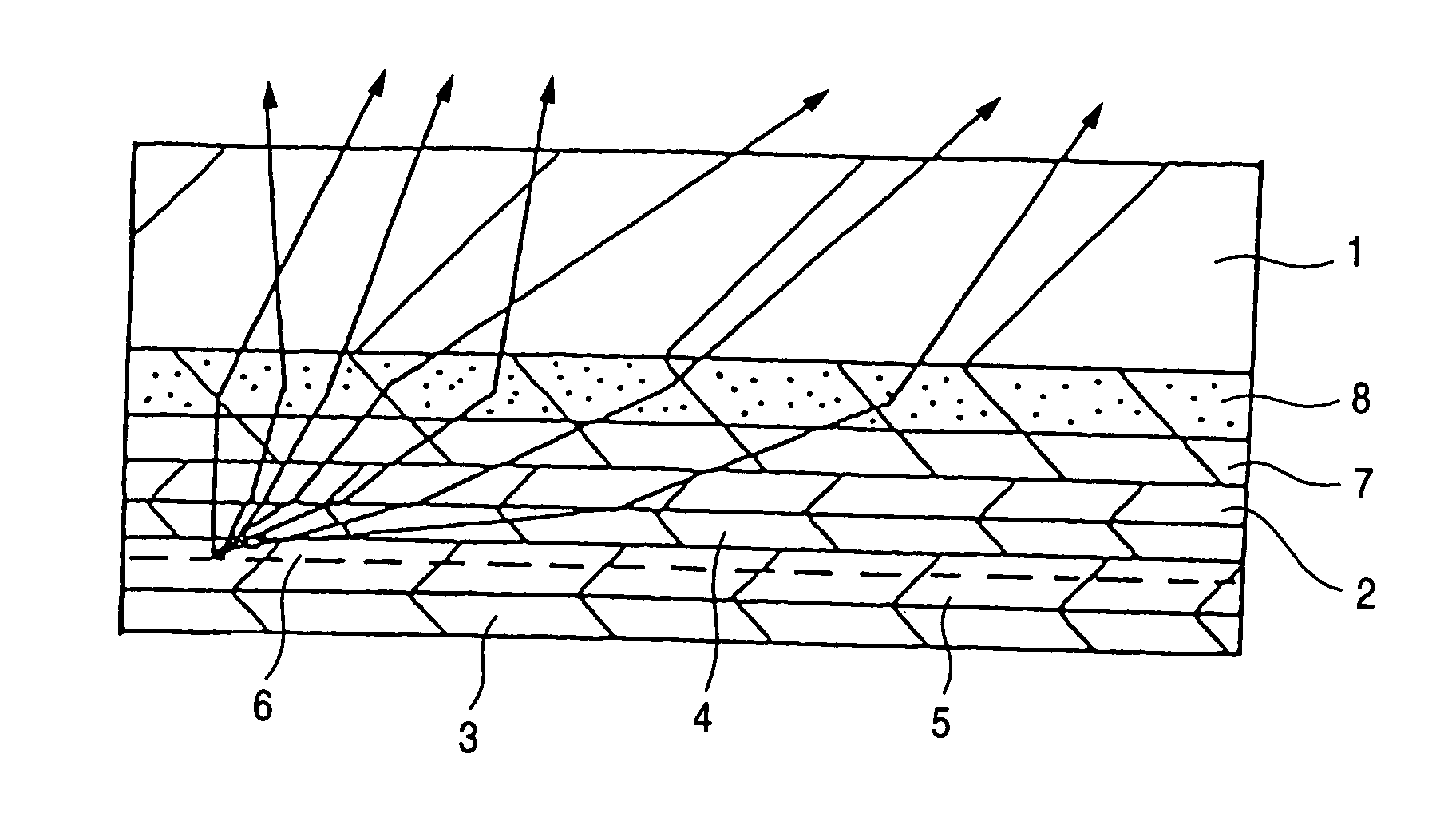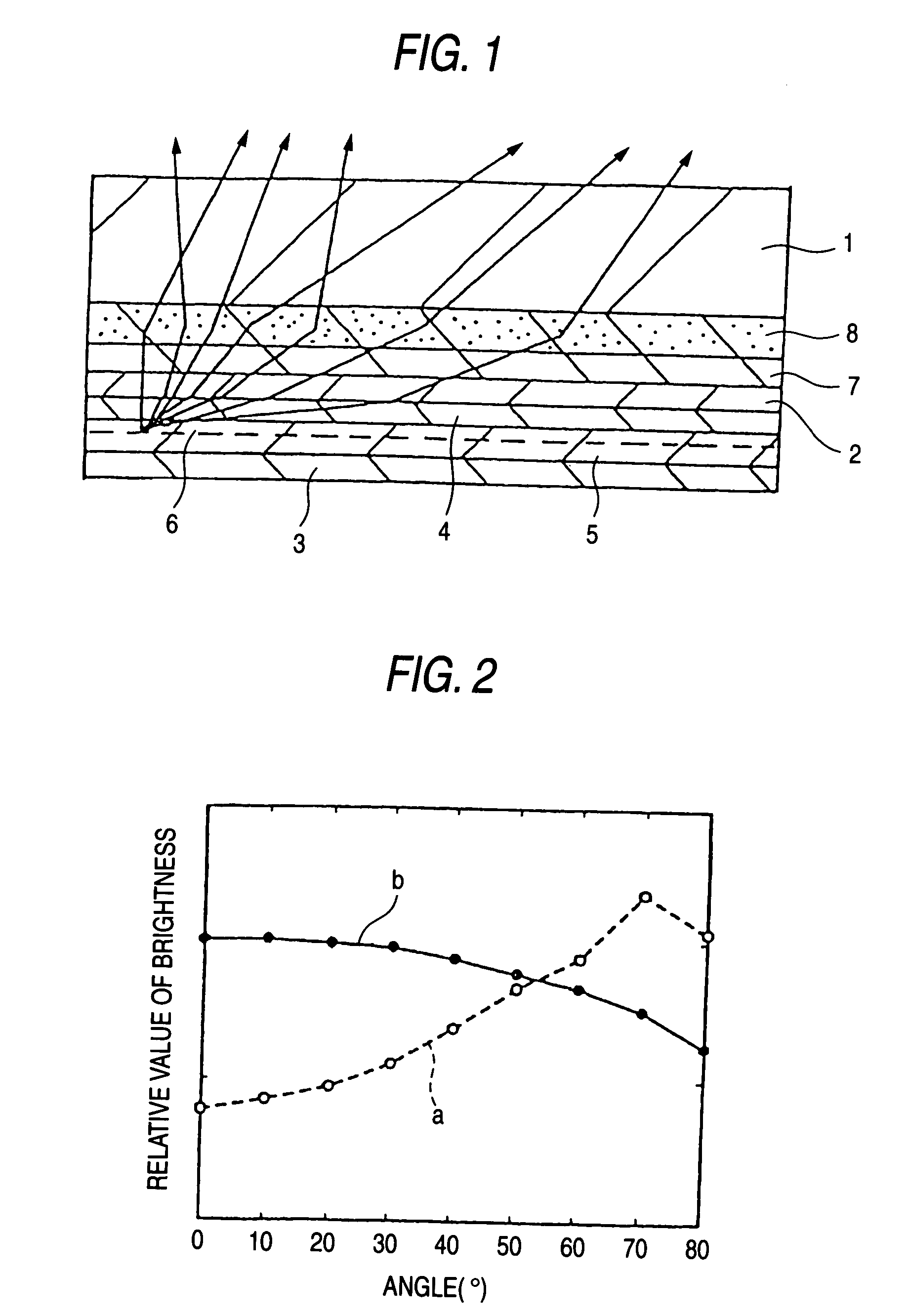Electroluminescence device, planar light source and display using the same
a technology of electric light source and light source, which is applied in the direction of instruments, discharge tube luminescnet screens, natural mineral layered products, etc., can solve the problems of not contributing to the enhancement of light extraction efficiency, and achieve the effects of improving light emission efficiency, low efficiency, and high light emission efficiency
- Summary
- Abstract
- Description
- Claims
- Application Information
AI Technical Summary
Benefits of technology
Problems solved by technology
Method used
Image
Examples
synthesis example 1-1
[0201] 29.89 g (171.6 mM) of tolylenediisocyanate (an isomer mixture: T-80, product of Mitsui Takeda Chemical Co.), 94.48 g (377.52 mM) of 4,4′-diphenylmethanediisocyanate, 64.92 g (308.88 mM) of naphthalenediisocyanate and 184.59 g of toluene were mixed in a 500 ml four-neck flask equipped with a stirrer, a dropping funnel, a reflux condenser and a thermometer. 8.71 g (51.48 mM) of 1-naphthylisocyanate and 0.82 g (4.29 mM) of 3-methyl-1-phenyl-2-phospholene-2-oxide were added to the mixture and under stirring, the whole was heated to 100° C. and held thereat for two hours. The progress of the reaction was ascertained by infrared spectroscopy. More specifically, observation was made of a decrease in absorption of the N—C—O stretching vibration of the isocyanate (2,270 cm−1) and an increase in absorption of the N—C—N stretching vibration of the carbodiimide (2,135 cm−1). The end point of the reaction was ascertained by IR and the reaction solution was cooled to room temperature to yi...
synthesis example 1-2
[0202] 89.01 g (355.68 mM) of 4,4′-diphenylmethanediisocyanate, 24.92 g (118.56 μM) of naphthalenediisocyanate, 44.87 g (266.76 mM) of hexamethylenediisocyanate and 216.56 g of toluene were mixed in a 500 ml four-neck flask equipped with a stirrer, a dropping funnel, a reflux condenser and a thermometer. 7.52 g (44.46 mM) of 1-naphthylisocyanate and 0.71 g (3.705 mM) of 3-methyl-1-phenyl-2-phospholene-2-oxide were added to the mixture, the whole was stirred at 25° C. for three hours and under stirring, the whole was then heated to 100° C. and held thereat for two hours. The progress of the reaction was ascertained by infrared spectroscopy, More specifically, observation was made of a decrease in absorption of the N—C—O stretching vibration of the isocyanate (2,270 cm−1) and an increase in absorption of the N—C—N stretching vibration of the carbodiimide (2,135 cm−1). The end point of the reaction was ascertained by IR and the reaction solution was cooled to room temperature to yield ...
example 1-1
[0206] A toluene solution containing 70% by weight of silica particles having an average particle size of 0.5 μm was added to the polycarbodiimide resin solution as obtained in Synthesis Example 1-1 in the proportion of 20% by weight of the polycarbodiimide resin and the whole was stirred. The resulting dispersion was applied by an applicator to coat a glass substrate and was cured at 150° C. for one hour to form a transparent layer having a thickness of 25 μm and serving also as a light-diffusion layer on the glass substrate having a thickness of 1.1 mm. The refractive index of the glass substrate was measured with an Abbe refractometer and found to be 1.57 for the wavelength of 587.6 μm. The resulting sample had a haze of 87.3% as measured by a reflectance and transmittance meter (HR-100 of Murakami Color Research Laboratory).
[0207] Then, an ITO layer having a thickness of 100 nm was formed by DC sputtering from an ITO ceramic target (In2O3:SnO2=90% by weight:10% by weight) to fo...
PUM
| Property | Measurement | Unit |
|---|---|---|
| refractive index | aaaaa | aaaaa |
| mean particle size | aaaaa | aaaaa |
| surface roughness | aaaaa | aaaaa |
Abstract
Description
Claims
Application Information
 Login to View More
Login to View More - R&D
- Intellectual Property
- Life Sciences
- Materials
- Tech Scout
- Unparalleled Data Quality
- Higher Quality Content
- 60% Fewer Hallucinations
Browse by: Latest US Patents, China's latest patents, Technical Efficacy Thesaurus, Application Domain, Technology Topic, Popular Technical Reports.
© 2025 PatSnap. All rights reserved.Legal|Privacy policy|Modern Slavery Act Transparency Statement|Sitemap|About US| Contact US: help@patsnap.com



